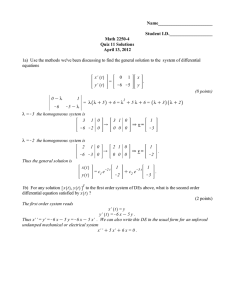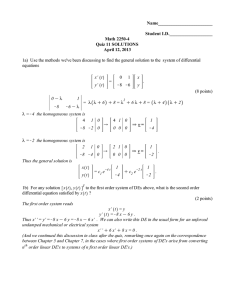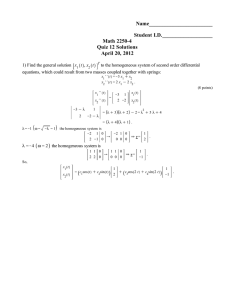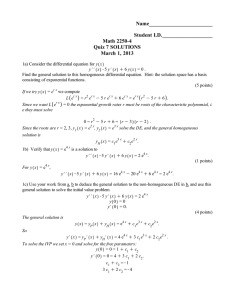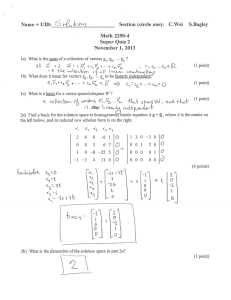6 Systems Represented by Differential and Difference Equations Recommended
advertisement
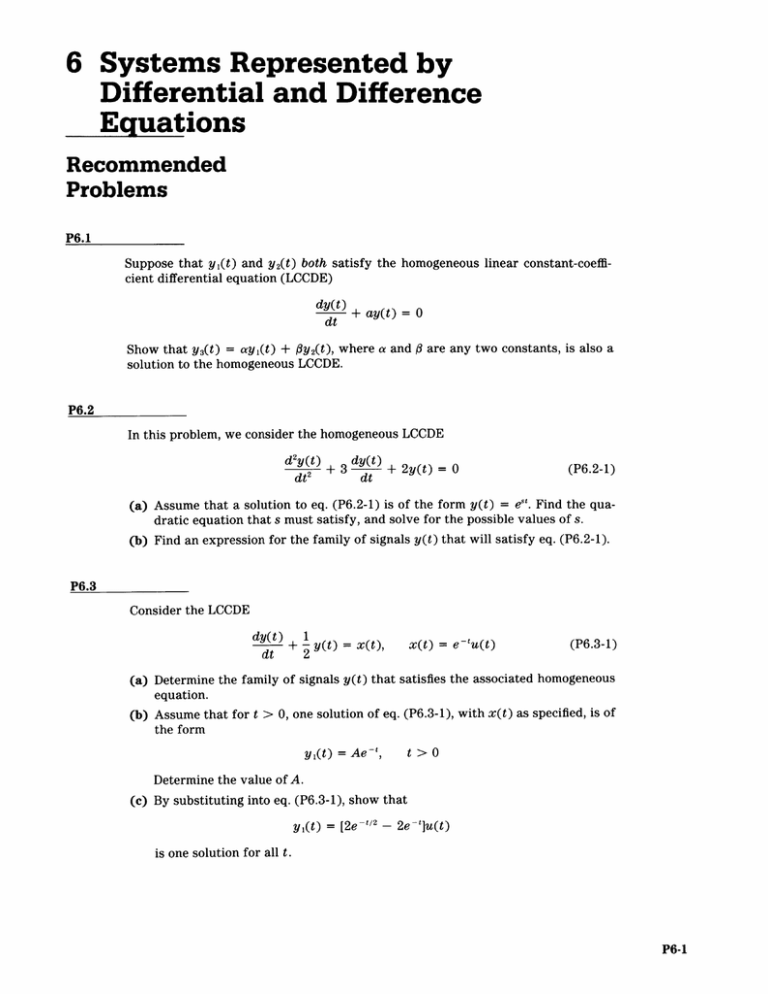
6 Systems Represented by
Differential and Difference
Equations
Recommended
Problems
P6.1
Suppose that y 1(t) and y 2(t) both satisfy the homogeneous linear constant-coeffi­
cient differential equation (LCCDE)
dy(t) + ay(t)
= 0
dt
Show that y 3 (t) = ayi(t) + 3y2 (t), where a and # are any two constants, is also a
solution to the homogeneous LCCDE.
P6.2
In this problem, we consider the homogeneous LCCDE
d 2yt + 3 dy(t) + 2y(t) = 0
dt 2
dt
(P6.2-1)
(a) Assume that a solution to eq. (P6.2-1) is of the form y(t) = es'. Find the qua­
dratic equation that s must satisfy, and solve for the possible values of s.
(b) Find an expression for the family of signals y(t) that will satisfy eq. (P6.2-1).
P6.3
Consider the LCCDE
dy(t) + 1 y(t) = x(t),
2
dt
x(t) = e- t u(t)
(P6.3-1)
(a) Determine the family of signals y(t) that satisfies the associated homogeneous
equation.
(b) Assume that for t > 0, one solution of eq. (P6.3-1), with x(t) as specified, is of
the form
y 1(t) = Ae-,
t > 0
Determine the value of A.
(c) By substituting into eq. (P6.3-1), show that
y 1(t) = [2e -t/2 - 2e-']u(t)
is one solution for all t.
P6-i
Signals and Systems
P6-2
P6.4
Consider the block diagram relating the two signals x[n] and y[n] given in Figure
P6.4.
x[n]
+
1 y[n]
1
2
Figure P6.4
Assume that the system described in Figure P6.4 is causal and is initially at rest.
(a) Determine the difference equation relating y[n] and x[n].
(b) Without doing any calculations, determine the value of y[ -5] when x[n] = u[n].
(c) Assume that a solution to the difference equation in part (a) is given by
y[n] = Kanu[n]
when x[n] = b[n]. Find the appropriate value of K and a, and verify that y[n]
satisfies the difference equation.
(d) Verify your answer to part (c) by directly calculating y[O], y[l], and y[2].
P6.5
Figure P6.5 presents the direct form II realization of a difference equation. Assume
that the resulting system is linear and time-invariant.
x[n]
y[n]
r0n] O +
D
-2
+1 3
Figure P6.5
(a) Find the direct form I realization of the difference equation.
(b) Find the difference equation described by the direct form I realization.
(c) Consider the intermediate signal r[n] in Figure P6.5.
(i) Find the relation between r[n] and y[n].
(ii) Find the relation between r[n] and x[n].
(iii) Using your answers to parts (i) and (ii), verify that the relation between
y[n] and x[n] in the direct form II realization is the same as your answer
to part (b).
Systems Represented by Differential and Difference Equations / Problems
P6-3
P6.6
Consider the following differential equation governing an LTI system.
dx(t)
dytt)
dt + ay(t) = b di
+ cx(t)
dt
dt
(P6.6-1)
(a) Draw the direct form I realization of eq. (P6.6-1).
(b) Draw the direct form II realization of eq. (P6.6-1).
Optional
Problems
P6.7
Consider the block diagram in Figure P6.7. The system is causal and is initially at
rest.
r [n]
x [n]
+
y [n]
D
-4
Figure P6.7
(a) Find the difference equation relating x[n] and y[n].
(b) For x[n] =
[n], find r[n] for all n.
(c) Find the system impulse response.
P6.8
Consider the system shown in Figure P6.8. Find the differential equation relating
x(t) and y(t).
x(t)
+
a
r(t)
a
+
b
Figure P6.8
y t
Signals and Systems
P6-4
P6.9
Consider the following difference equation:
y[n] - ly[n
-
1]
= x[n]
(P6.9-1)
with
x[n] = K(cos gon)u[n]
(P6.9-2)
Assume that the solution y[n] consists of the sum of a particular solution y,[n] to
eq. (P6.9-1) for n
0 and a homogeneous solution yjn] satisfying the equation
Yh[flI
-
12Yhn -
1]
=0.
(a) If we assume that Yh[n] = Az", what value must be chosen for zo?
(b) If we assume that for n
0,
y,[n] = B cos(Qon + 0),
what are the values of B and 0? [Hint: It is convenient to view x[n] =
Re{Kej"onu[n]} and y[n] = Re{Ye"onu[n]}, where Y is a complex number to be
determined.]
P6.10
Show that if r(t) satisfies the homogeneous differential equation
d=r(t)
m
0
dt
and if s(t) is the response of an arbitrary LTI system H to the input r(t), then s(t)
satisfies the same homogeneous differential equation.
P6.11
(a) Consider the homogeneous differential equation
dky)
N
(P6.11-1)
k~=0 dtk
k=ak
Show that if so is a solution of the equation
N
p(s)
=
E akss
(P6.11-2)
0,
=
k=O
then Aeso' is a solution of eq. (P6.11-1), where A is an arbitrary complex
constant.
(b) The polynomial p(s) in eq. (P6.11-2) can be factored in terms of its roots
S1, ...
,S,.:
p(s)
=
aN(S
-
SI)1P(S
-
S2)2
.
.
.
(S
-
Sr)ar,
where the si are the distinct solutions of eq. (P6.11-2) and the a are their mul­
tiplicities.Note that
U1 +
o2 +
+
Ur
= N
In general, if a, > 1, then not only is Ae''' a solution of eq. (P6.11-1) but so
is Atiesi' as long as j is an integer greater than or equal to zero and less than or
Systems Represented by Differential and Difference Equations / Problems
P6-5
equal to oa - 1. To illustrate this, show that if ao = 2, then Atesi is a solution
of eq. (P6.11-1). [Hint: Show that if s is an arbitrary complex number, then
N
ak
dtk
Ap(s)te' t + A
=
estI
Thus, the most general solution of eq. (P6.11-1) is
p
ci-1
(
Aesi ,
i=1 j=0
where the Ai, are arbitrary complex constants.
(c) Solve the following homogeneous differential equation with the specified aux­
iliary conditions.
d 2 y(t)
2
dt2
+ 2 dy(t)
+ y(t) = 0,
dt
y(0) = 1, y'() = 1
MIT OpenCourseWare
http://ocw.mit.edu
Resource: Signals and Systems
Professor Alan V. Oppenheim
The following may not correspond to a particular course on MIT OpenCourseWare, but has been
provided by the author as an individual learning resource.
For information about citing these materials or our Terms of Use, visit: http://ocw.mit.edu/terms.
